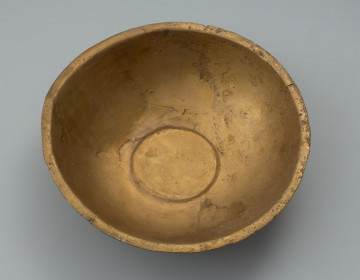
Bucket with straight handle
900 — 1250
National Museum in Szczecin
Part of the collection: Middle Ages
Carnelian is a quartz rock with an orange-red colour caused by admixtures of iron minerals. It resembles amber in appearance, but is characterised by a less transparent texture. In the early Middle Ages, carnelian was used mainly for jewellery making, often combining products made of different materials in the final piece. Beads of this raw material were usually formed in two ways: the smooth cut was used to create spherical beads, while the faceted cut was used to create cuboidal pieces, such as the piece from Police. It took the form of an elongated cuboid, which had its edges filed down to give it an octagonal cross-section, and the shorter edges smoothed. A slight discrepancy can be seen in the channel drilled on two sides. There are no known workshops in Western Pomerania that may have produced carnelian beads. The high precision of the products does not indicate that it could have been made by inhabitants on their own. They do, however, occur in treasures along with Arab coins. It can therefore be assumed that the finished products arrived in Central Europe from the east, probably through Scandinavian intermediaries. Ewa Górkiewicz-Bucka
Author / creator
Object type
bead, decorative element
Technique
drilling, hewn, smoothing
Material
carnelian
Origin / acquisition method
field research
Creation time / dating
Creation / finding place
Owner
Muzeum Narodowe w Szczecinie
Identification number
Location / status

900 — 1250
National Museum in Szczecin

1101 — 1200
National Museum in Szczecin

700 — 1250
National Museum in Szczecin
DISCOVER this TOPIC
Museum of King Jan III's Palace at Wilanów
DISCOVER this PATH
Educational path